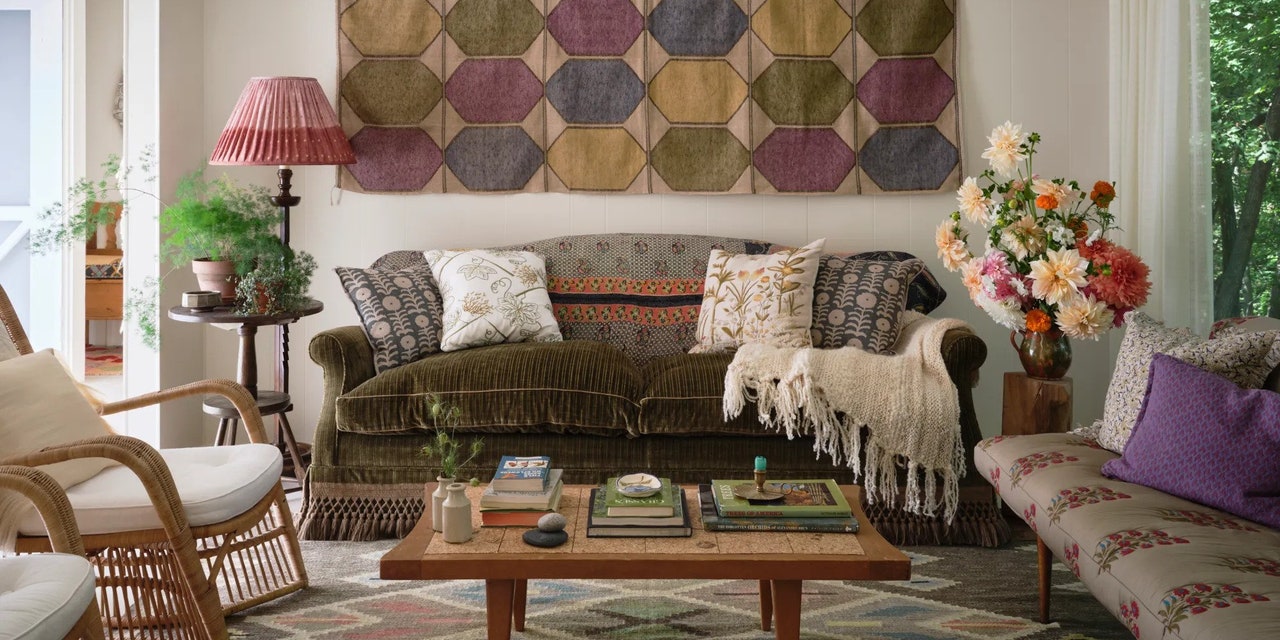We’ve ridden the waves of 1970s revivals, wall-to-wall carpeting, the rise and fall of the Ultrafragola, and bouclé upholstery. When we type “interior design trends 2024” into our crystal balls (or indeed, into Google) what are we likely to find? AD PRO consulted the experts, and 2024 promises to be a year of thoughtfully chosen offbeat colors, a mix-and-match approach to the designs of different time periods, and a return to romanticism, with jewel tones and florals offering a flirty, old-fashioned respite from the onward march of technology.
Stone Fruit Chic: Peach and Apricot
Soft, sweet, and just a bit tart, peach and apricot are the dominant hues in the home trends color forecasts for 2024. Pantone declared Peach Fuzz its color of the year, and Leatrice Eiseman, executive director of the Pantone Color Institute describes it as “a color radiant with warmth and modern elegance.” Gemma Riberti, head of interiors at trend forecasting agency WGSN, notes that her team has had its eyes on orange. In particular, they note its emergence as “a recharging near-bright in the wellness sector” and as a vivacious alternative to traditional pastels. WGSN’s color of 2024, Apricot Crush, “can be easily paired with neutrals and naturals, and is suitable for textiles, glass, bath, and bedroom products” Riberti says, “but you can also work it to create intriguing narratives: offset it with greens, purples, and blues for vibrant contrast.”
Become an AD PRO member today for only $25 $20 to join the Taking Charge of Your Finances workshop with Amy Astley

The classic technique of selecting chromatic bedfellows from opposite sides of the color wheel is also in Champalimaud Design’s toolkit. Principal Courtney Brannan tells AD PRO that when it comes to interior design trends in 2024, “we are seeing all the possibilities of peach and turquoise tones.” Though these shades have a tropical feel to them, they “can also feel neutral,” she says. Case in point: “At the Ritz-Carlton, Grand Cayman, turquoise creates an amplifying, formal statement surrounding the Silver Palm Bar.” Meanwhile, in New York City’s West Village, an apartment’s peach plaster wall “has a much more understated presence, calmly backgrounding the artful living space around it.”
That’s So Metal
It’s back to the essential elements (literally) for home decor trends in 2024: chrome, steel, and aluminum are suddenly everywhere. Pinterest Predicts 2024 includes a “Hot Metals” board with a distinctly surrealist aesthetic—gleaming surfaces that resemble the shiny sinew of liquid mercury.
David Michon, author of the Substack newsletter For Scale, thinks this is a natural consequence of the early-2020s overload of earth tones. “The desperate search for some kind of warmth in this cold world has exhausted ‘earthy’ browns and ‘meditative’ grays,” he notes. But don’t be too quick to write off these metallic finishes as industrial: “The many stainless-steel explorations of Milan’s Concorde, Harry Nuriev, or Tejumola Butler Adenuga show us that, in fact, steel simply reflects.” In general, says Michon, these metals amplify whatever vibe a room is already giving. With one notable exception: “stainless-steel appliances, which remain overrated.”
House of Hunt founder Holly Hunt concurs, but with a slightly more muted finish: “I foresee bright aluminums and silver gaining popularity in 2024 after years of gold and black dominating metal hardware and accessories,” she tells AD PRO. “However, I tend to avoid metals that are too shiny and prefer the richness of a brushed chrome or nickel, as they give a more polished and sophisticated look.” Adding to the evidence: Earlier this month, Nifembi Marcus Bello presented an eye-catching suite of cast-aluminum furniture at Design Miami.
Dark and Deep: Jewel Tones
The saturated hues of precious gems are giving the palette of 2024 design trends a sense of velvety mystery. According to Rob Natale, chief of design at Sixpenny, this is thanks in part to the recent dominance of neutrals across interiors. “People are rediscovering color in their homes, which is a welcome shift from the all-neutral palette we’ve seen for several years, and jewel tones are at the forefront of that shift,” he says. “It’s a perfect way to incorporate richness, whether as an accent or as the centerpiece for a space since they create such a strong counterpoint to almost any look.” (Heeding their own wisdom, Sixpenny is currently selling furnishings in an array of gem-inspired hues.)
Hunt echoes Natale’s intriguing inclusion of amber as a jewel tone—a category that tends to run cool rather than warm—characterizing it as “a stunning and versatile shade.” Giancarlo and Jane Keltner de Valle’s Connecticut house, and its honey-hued dining room, makes another compelling argument for the trend.
The New Romantics
Unspool your ribbons: Romanticism isn’t just for the 19th century—or the 1980s. Romantic design is more than the clichéd embodiment of Valentine’s Day aesthetics. When embraced with confidence, pinks, reds, florals, lace, and ribbons can be sensual and provocative. Though we may be in the midst of a “bow backlash,” according to Times commentators and Instagram’s peanut gallery, romanticism is undoubtedly having a moment. Proponents of the carefree style will be relieved to learn that maximalist florals are about to bloom: “From pillows to bedding to area rugs, we’re seeing botanical inspiration creep into all textiles,” says the team from the Citizenry, which shares that the company’s spring collection will feature muted floral patterns in weaving and block prints.” Kaiyo further notes that with Cottagecore and Grandmillenial styles fading from their dominance in home decor trends, bigger-than-life blooms and floral maximalism are pushing subtle blooms to one side.
Where fresh florals aren’t possible—or are just too tricky to maintain, Citizenry recommends opting for blossoms of the everlasting variety. Others are apparently already doing so: “This past holiday, we saw an increased investment in fresh and dried holiday florals, especially in unexpected varieties.”
The romantic moment isn’t just about flowers, however. As Dayna Isom Johnson, Etsy’s in-house trend expert, puts it: “It’s a celebration of love, nostalgia, and savoring life’s simple pleasures.” In line with their own color of the year, Berry, Etsy is seeing shoppers gravitate towards juicy-hued goods, from bedding and throw pillows to candlesticks “to help add a romantic warmth to their homes.”
Now and Then: Mixing and Matching Historical Eras
Michael Diaz-Griffith, executive director of the Design Leadership Network and author of The New Antiquarians says that where American antiques are concerned, 2023 was “like the tidal wave at the end of Deep Impact, and we are all Téa Leoni: subsumed.” This is as much a reflection of shifting taste as it is the result of exciting new scholarship in design history. “The most important trend in Americana doesn’t relate directly to aesthetics,” he tells AD PRO, “it’s our evolving understanding of the category itself. American material culture was (and is) made by craftspeople of color, women and girls, Native Americans, immigrants, and others who have traditionally been marginalized in the pages of history, and our shift in focus from the parlor to the workshop is resulting in a new understanding of who Americana was by and for: all of us.”
That history includes a somewhat avant garde approach to mixing pieces of Americana into modern interiors. “I’m particularly excited by the way patrons of collectible design—including hard-line modernists—are beginning to appreciate the more minimal, formalist expressions of American design,” he adds. “There is a precedent for this: In the early 20th century, modern artists and their avant-garde patrons practically invented the market for Americana as we know it today. They saw a parallel between modern art and the bold, graphic use of line in American fine and decorative arts. When viewed through a social lens, Americana feels just as fresh. The Shakers, for example, didn’t have much sex, but they were anything but tame, pushing functionalism toward an ecstatic edge the Bauhaus could only dream of. Who wouldn’t want to own a piece of that radical American history in 2024? Set your auction alerts.”
Looking for even more intel on design in 2024? AD PRO members receive exclusive access to AD PRO’s 2024 Interior Design Forecast, a deep dive into the technology, sustainability trends, floor plans, and decor that will define the year ahead.
Grow your business in 2024 with the AD PRO Directory

